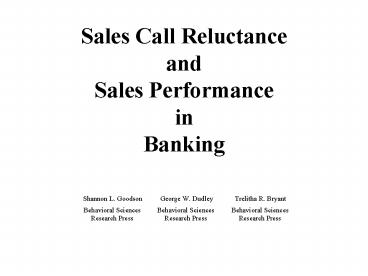Sales Call Reluctance and Sales Performance in Banking - PowerPoint PPT Presentation
1 / 14
Title:
Sales Call Reluctance and Sales Performance in Banking
Description:
Visibility management is a critical core competency associated with success in ... managers, trainers and consultants, are conflicted about or hesitant to engage ... – PowerPoint PPT presentation
Number of Views:71
Avg rating:3.0/5.0
Title: Sales Call Reluctance and Sales Performance in Banking
1
Sales Call ReluctanceandSales
PerformanceinBanking
2
Problem
- Visibility management is a critical core
competency associated with success in the direct
sales profession. - To be successful, salespeople must consistently
make themselves, their products and services
visible in the marketplace. - They accomplish this by prospecting, initiating
contact on a regular basis with prospective
buyers through the use of the telephone, group
presentations, social networking, referrals from
existing customers and other organization-specific
practices. - However, some salespeople, managers, trainers and
consultants, are conflicted about or hesitant to
engage in these visibility management behaviors
and may consequently avoid them or dismiss their
importance.
3
Problem (Continued)
- Escape and avoidance behaviors related to sales
prospecting situations are collectively referred
to as sales call reluctance. - Many studies have linked lower levels of sales
call reluctance to higher levels of sales success
in a variety of sales-oriented cultures and
settings. - This study examined the relationship between call
reluctance diagnostic measures and performance in
salespeople working in the banking industry.
4
Method
- The Sales Preference Questionnaire (SPQ) is a
limited purpose, self-descriptive inventory
designed to diagnose fears specifically
associated with initiating first contact for
sales prospecting purposes. - It consists of 19 diagnostic scales plus two
composite measures (Table 1). - One hundred and sixty-two salespeople employed by
a bank to sell banking products and services
were participants in the study.
5
Method (Continued)
- Each individual completed the SPQ as part of the
organizations standard career development
protocol. - Due to the limited sample size, four scales were
selected for analysis based on results of several
previous SPQ studies of high and low producers
across industries, organizations and national
settings. - Objective sales rankings were assigned by
supervisors based on the organizations
proprietary weighted performance criteria. - Based on the outcome, salespeople were assigned
either a high or low production
classification.Twenty-eight did not meet criteria
for either high or low group inclusion, and were
not included in the study.
6
Data Analysis Results
- Logistic regression was used to analyze the data
due to the categorical nature of the criterion,
and our unwillingness to assume the variables of
interest were multivariate normal (as assumed for
discriminant analysis). - Means and standard deviations are presented in
Table 2. - Results of the logistic regression are summarized
in Table 3. - Consistent with prior sales call reluctance
research, Yielder, Doomsayer, and Prospecting
Goal Level were significant predictors of sales
success in the banking services setting.
7
Results (Continued)
- The model yielded an overall correct
classification rate of 78, based on accurate
prediction of 79 of high performers and 77 of
low performers.
8
Discussion
- Salespeople with higher levels of sales call
reluctance are likely to produce less than
salespeople with little or no hesitation to
initiate first contact with prospective buyers. - Results of this study are generally consistent
with results obtained in previous SPQ studies
which also utilized objective sales performance
criteria. - Results from studies where broader, more
objective ratings were used, tended to be more
inconclusive. This suggests that SPQs
behaviorally narrow approach may help reduce
uncertaintywhen narrow criteria such as earned
dollars of commissions are used, but less so in
situations were broad constructs such as
team-mindedness or empathy are preferred.
9
Discussion (Continued)
- The current study may have yielded anomalously
high classification accuracy due in part to
the narrow construction of sales used in the
banking sector and other company- specific
considerations. Call reluctance studies in the
past produced variance explanations typically
ranging from 9 to 30. ( Nagelkerke R2 for
the present study 47.)
- Cross-industry, company and nation studies
indicate that specific sales call reluctance
types which interfere with new business
generation in one setting can be comparatively
benign or non-existent in others.
10
Discussion (Continued)
- Additional U.S and multi-national research
projects are underway to further explore how call
reluctance impairs sales performance in various
industries, cultures and settings. - Efforts continue to explore alternative ways of
predicting sales call reluctance and producing
diagnostic measures to guide training
developmental applications. - Copies of this study will be available at
www.behavioralsciences.org
11
Table 1 (Narrative Description of SPQ Scales Goes
Here)
12
Table 2 SPQ DescriptiveStatistics Mortgage
Banking Sales N162
13
Table 3
1 Computed as log odds ratios.
14
References Demaris, Alfred, Logit Modeling, Sage
Publications, Inc., Thousand Oaks, Ca.,
1992. Dudley, G.W., Goodson, S.L., Sales
Preferences Questionnaire, Behavioral Sciences
Research Press, Dallas, Texas, 1989. Hintze,
Jerry, NCSS 2001, User Guide, NCSS, Kaysville,
Utah, 2001, pg. 3175-3246. Menard, Scott,
Applied Logistic Regression Analysis, 2nd
Edition, Sage Publications, Inc., Thousand Oaks,
Ca., 2002. Norusis, Marija J., SPSS Professional
Statistics 7.5, SPSS Inc., 1997, pg.
37-64. Nunnally J.C., Bernstein, I.H.,
Psychometric Theory, 3rd Edition, McGraw- Hill,
New York, 1994, 674-680, 704-705.





























![NOTE: To appreciate this presentation [and insure that it is not a mess], you need Microsoft fonts: PowerPoint PPT Presentation](https://s3.amazonaws.com/images.powershow.com/P1248118340ApzTI.th0.jpg?_=20201224124)

